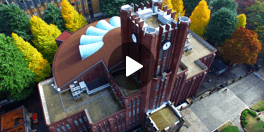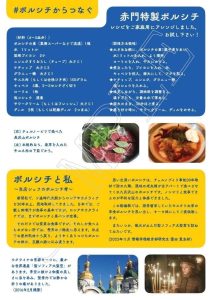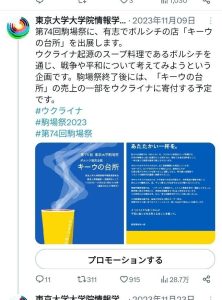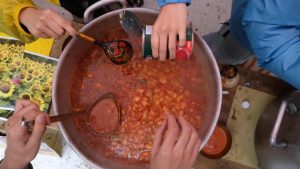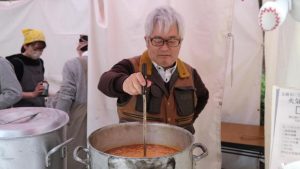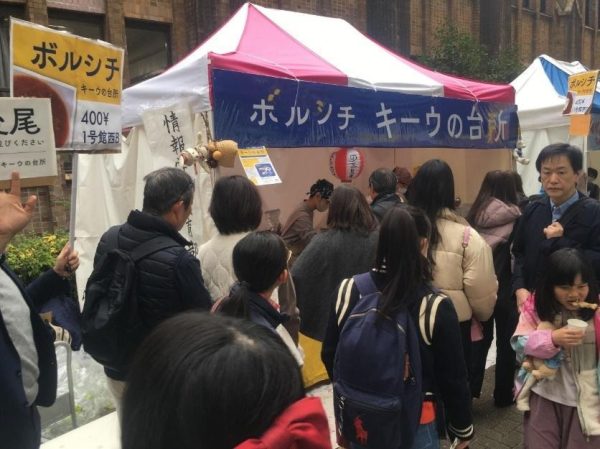
February 13, 2024
【情報学環教育部】「キーウの台所」を舞台にしたメディア実践の報告A media practice called “Kyiv Kitchen” by volunteers from the Undergraduate Research Student Program
ロシアによるウクライナ侵攻は収束が見通せない状況が続いています。現地の情勢に関心を寄せる教育部研究生の有志で「食」を通じて想いを馳せる取り組みを11月下旬に駒場祭で行いました。企画内容はウクライナの伝統料理ボルシチを振る舞うもので、その名も「キーウの台所」です。
企画提案者の一人が、社会人研究生で約30年間ウクライナやロシアを取材してきたジャーナリストの園田寛志郎さんです。園田さんは現地で仲良くなった人から「あなたがふだん食べているものを食べたい」と言われた経験があります。ウクライナの情報発信を食べ物を通じてできないかとこの企画を呼びかけ、約30人の研究生が参加しました。
今回の「キーウの台所」の出展では、広報活動や当日の運営に至るまで、日頃教育部で新聞記者や出版社、広告代理店といったメディアの実務家の方々から惜しみなく教えていただいている知見を生かすことができました。まず準備段階の広報活動では、在京の主要メディアや著名な方々約20人に個別に連絡し、この企画をお知らせしました。そのうち学環の渡邉英徳先生、東大名誉教授の上野千鶴子先生、そして筑波大学の東野篤子先生などからX上で応援のコメントを寄せていただき、それがSNS上で多く拡散されました。さらにはウクライナ国営通信社「ウクルインフォルム」の編集者にもリポストされ、現地のウクライナ人とみられる多数のユーザーから感謝や賛同のコメントが寄せられました。こうした発信が拡散につながり多数の来場につながりました。
内部むけにも情報発信を工夫しました。運営内容や企画にむけて募った資金の使途について進捗報告を週次で行ったり総会を行ったりし、経済学部出身の学生を中心に納得感がある運営を心がけました。
当日に配布するチラシも研究生がデザインしました。店の理念「ボルシチからつなぐ」のコピーを掲載したチラシは、レイアウトや図表の色にウクライナの国旗の色を使うなど細部まで企画趣旨が伝わるよう工夫しました。また、ウクライナ侵攻について国際関係論を専攻する研究生を中心に想定問答集を作成し、来店者からの質問に答えられるよう努めました。
様々な工夫を凝らした結果、11/24-26の期間中にのべ1369人と非常に多くの方にボルシチを振る舞うことができました。参加した研究生は「理論から実践へ移すこともでき、いい経験だった」と振り返っています。教育部の講義でのメディアについての学びやそれぞれの専攻をいかした専門的な議論が交わされ、教育部らしい豊かな学びの場が広がりました。
記事:山下凜太朗(教育部研究生)
The Russian invasion of Ukraine continues with no end in sight. In an effort to share information regarding the ongoing situation and to cast light on the lives of the Ukrainian people, volunteers among the research students from the Undergraduate Research Student Program organized an initiative at the Komaba Festival in late November by serving “borscht,” a traditional Ukrainian dish.
One of the proposers of this project, which we named “Kyiv Kitchen,” was Kanshiro Sonoda, a student and journalist who has been covering Ukraine and Russia for about 30 years. Recalling how a local acquaintance expressed interest in tasting the food he usually eats, Sonoda called for this project in the hope that it would be possible to transmit information about Ukraine through food. Nearly 30 research students took part, making use of the knowledge they gained in the Undergraduate Research Student Program, from promotional activities to the management of the stall during the Komaba Festival, which took place from November 24 to 26.
During the preparation stage, for example, students put the promotional activities into practice by utilizing tips obtained in classes where front-line media practitioners such as newspaper journalists, publishers and advertisers generously share their expertise. We directly contacted about 20 reporters from the major media in Tokyo and prominent individuals, resulting in many comments supporting our project on social media. Those who shared information about this project on X included Professor Hidenori Watanave of GSII, Univ. of Tokyo Professor Emeritus Chizuko Ueno and Professor Atsuko Higashino of Tsukuba University. An editor at the Ukrainian state news agency Ukrinform also reposted, drawing comments of gratitude and support from a number of users who appeared to be Ukrainians in their home country. We believe these messages spread and led to a large number of visitors to our “Kyiv Kitchen” at the Komaba Festival. Information on the progress of the preparation as well as the use of funds raised for the project was shared among the participating students on a regular basis.
Meanwhile, some students worked on designing flyers to post and distribute at the Komaba Festival site. The flyer, which included the stall’s philosophy “Connecting through Borscht,” utilized the colors of the Ukrainian flag in the layout and also incorporated charts to convey the purpose of the project down to the smallest detail. In addition, some other research students majoring in international relations compiled a collection of questions and answers about the invasion of Ukraine to respond to various questions from visitors to the stall.
As a result of our efforts and various innovations, we were able to serve borscht to a large number of visitors – a total of 1369 bowls – during the three days. The research students who participated reflected that it was a good experience for them, as it also became a unique opportunity to put theory to practice. The students were able to utilize the knowledge obtained through the classes and engage in professional discussions, creating a rich learning environment that is typical of the Undergraduate Research Student Program.
Text: Rintaro Yamashita (Research Student)
English Proofreading: David Buist (Project Senior Specialist)

